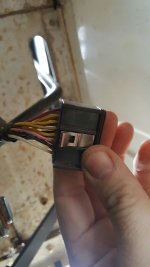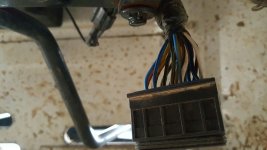Kind of a long post but thought I would share.
Use the following suggestions at your own risk. These are steps that worked for me. Your mileage may vary. There are steps that jumper safety features built in to protect operators; only do this if you fully understand what you are doing and know how to return the tractor to a safe operating condition prior to using it.
Steps to troubleshoot a no start condition where the tractor does not attempt to turn over on a bobcat CT230:
Check fuses are not blown fuse panel under ignition switch near firewall.
Check battery is charged; check all connections for corrosion, clean as necessary
Check safety switches are free to move. The safety circuit operates on 12 volts going through a 5-amp fuse. The operational control unit (OPCU) receives 12 volts when the switch is closed. Each switch is wired in parallel to the OPCU.
Safety switches on CT230 that affect starting:
Travel pedal switch located under floorboard below travel pedal. Sometimes rocks or twigs get stuck between switch and plate preventing plate from returning to close switch contact.
Rear PTO switch should show PTO symbol on dash when PTO is engaged or when switch is not closed. With tractor off and Key in run engage and disengage PTO to verify light changes each time to verify switch is working correctly. Switch is located at end of PTO handle between wheel well and transmission.
Mid PTO switch should show PTO symbol on dash when engaged. Tractors without a mid PTO will be prewired for mid PTO. It is located near the rear PTO switch and has a jumper to maintain 12 volts to the Operational control unit. This jumper can be pulled to verify mid PTO light turns on to verify that part of the circuit, then re-install jumper.
Seat switch located under seat.
Check voltage is making it to the starter relay as follows:
Have someone sitting in the seat to make up the safety switch or jumper the seat switch for testing, ensure PTO痴 are not engaged and travel pedal not forward or reverse.
Pull engine start relay located in engine compartment on right side as you are sitting on the tractor. It is the first of 3 relays and one controller on the firewall.
Check for 12 volts at the blue/black wire in the connector for the relay when key switch is in the start position.
If 12 volts is present, it is likely the relay is faulty. To test if the relay is faulty you could swap the relay with the preheat relay which is the 3rd relay over on the firewall. Turn key on and see if the glow plugs light with switch in run position. If they do not light up, the relay is bad.
The tractor starter can be jumpered by placing wire between the red/blue and the red wire in the connector for the start relay. This acts just like taking the key switch to the start position so do not leave the jumper installed once the tractor is running as the starter will remain engaged.
If there is 12 volts at the Blue/Black wire and the tractor will not turn over by jumpering across the Red/Blue and the Red wire it is likely the issue is in the starter.
If 12 Volts is not present on the Blue/Black wire in the start relay connector, it is likely a safety switch not sending 12 volts to the OPCU. Continue to test each safety switch.
To test if each switch is closing and opening using a voltmeter do the following?

Locate the Operational control unit located under the left side of the tractor as you are sitting on the tractor. It is a black box about 4 x 4 by 1? It is mounted on the transmission casing under the seat. There is a 16-pin connector going in the bottom of the OPCU. Follow the wiring harness while under the tractor to the transmission and you will likely run into the OPCU.
Key must be in the Run position to perform the following tests:
Check for 12 volts at each of the following locations.
Red/blue wire this is the 12 volts coming from the fuse panel feeding safety switches. 1st wire from right with connector removed from OPCU. If 12 volts is not present here the rest of the tests will not be able to be performed. If 12 volts is not present then check 5-amp fuse installed with clean contacts. Fuse in the location with the picture of the computer. Check resistance between fuse block and OPCU.
Seat Switch Have someone sitting in seat and check 12 volts on yellow wire. Should be 5th wire from the right.
Mid-PTO switch Yellow/blue wire. 4th wire from right. Should have 12 volts here even if tractor is not equipped with mit-PTO as the tractor comes pre-wired.
Rear PTO switch Yellow/black wire. 3rd wire from right
Travel pedal switch - Yellow/white wire. 2nd wire from right.
If 12 volts could not be obtained at each of the locations there is likely a break in the wire from the switch to the OPCU. Check resistance between the switch and the OPCU and look for breaks along the wire harness.
Return tractor to safe operating condition as follows:
Repair any issues discovered during troubleshooting.
Ensure seat safety switch is installed and wires connected.
Ensure travel pedal safety switch installed with wires connected.
Ensure PTO switch installed with wires connected.
Ensure OPCU 16 pin connector installed and ground wire connected if removed while troubleshooting.
Best of luck in troubleshooting
Here is what I found when troubleshooting my no start condition.




